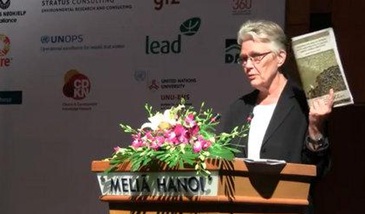 In a keynote address to some 500 participants at the 6th International Conference for Community-based Adaptation in Hanoi, Ms. Wahlström said it was important that government policies anticipate the risks in the decades to come as institutions set up to respond to today's disasters may not be able to do so in the near future.
In a keynote address to some 500 participants at the 6th International Conference for Community-based Adaptation in Hanoi, Ms. Wahlström said it was important that government policies anticipate the risks in the decades to come as institutions set up to respond to today's disasters may not be able to do so in the near future.
"Community, enterprises and every family all need to understand hazard and disaster risk assessment to know their vulnerabilities and to determine appropriate actions to reduce their own risks.
"We must strengthen institutions to address disaster and climate risks in an integrated manner for positive impacts at community level. Access to hazard and disaster risk information is key. And disaster loss data is the pre-requisite for governments to account for disaster losses and make well-informed decisions on development investment for the future", said Wahlström.
Community-Based Disaster Risk Management is a specific area under the Partnerships for Disaster Reduction in Southeast Asia - a project being implemented in seven Southeast Asian countries since 2001 with ECHO financial support. It focuses on institutionalizing community-based disaster risk management in government policy and in government departments.
The institutionalization of CBDRM in Viet Nam means that all tiers of government will now involve communities in disaster risk management. Communities will be involved in policies and plans, allocation of funds for CBDRM activities, and operational level staff will provide support. Technical resource centers are also to be established.
The National Climate Change Strategy, launched last month, was rolled out with an announcement that Viet Nam had ratified the UN Framework Convention on Climate Change and Kyoto Protocol and is now in the process of completing legal documents on the control and mitigation of natural disasters.
The strategy is comprised of six components with 10 strategic tasks to deal with climate change. It outlines overall objective and priority projects with a vision to 2100.
Reviewing her visit, Ms. Wahlström said she was impressed with the ambitious target of the Vietnamese Red Cross to build 500 safe communes at sub-district level based on vulnerability, hazard and capacity assessments.
"Other Red Cross activities such as mangrove forestry and the training of Master Trainers who are helping the Government Community-based Disaster Risk Management (CBDRM) Programme are good examples of how organizations can contribute to reducing risk", she stated.
"In my meeting with the Viet Nam Women's Union, I also saw great potential for the Union to include women in disaster risk reduction work, not as victims, but as a source of strength. It is important that these organizations participate proactively in decision making and implementation of disaster and climate risk reduction activities", urged Wahlström.
Ms. Wahlström departed from Viet Nam for Cambodia today where she begins a six-day mission in one of South-East Asia's most flood ravaged countries.
In Cambodia, she is scheduled to meet with Prime Minister, Samdech Techo Hun Sen; Minister of Foreign Affairs and International Cooperation, Hor Namhong; and Minister and Vice Chairman of the Cambodia National Committee for Disaster Management, Nhim Vanda.
Cambodia is the current Chair of the Association of South East Asian Nations (ASEAN). Ms. Wahlström is expected to propose that the Cambodian Government convene an ASEAN leader dialogue on disaster risk reduction and lead the post 2015 Hyogo Framework for Action (HFA) discussions in ASEAN as well as the implementation of a new Asian Disaster Management and Emergency Response (ADMER) after 2015.
Flooding is a recurring damaging event in Cambodia. Last year 1.64 million people were affected; 700,000 of them were children.